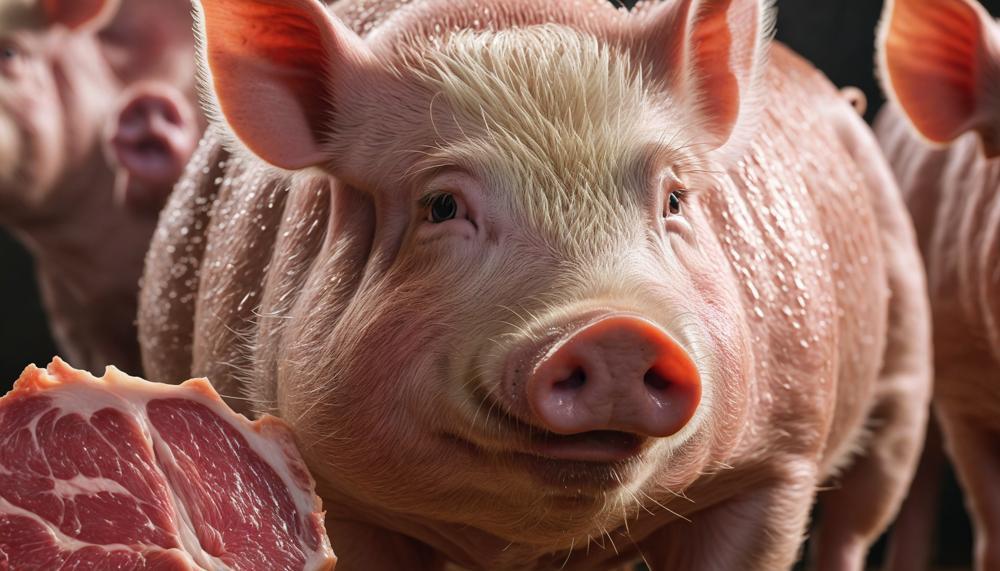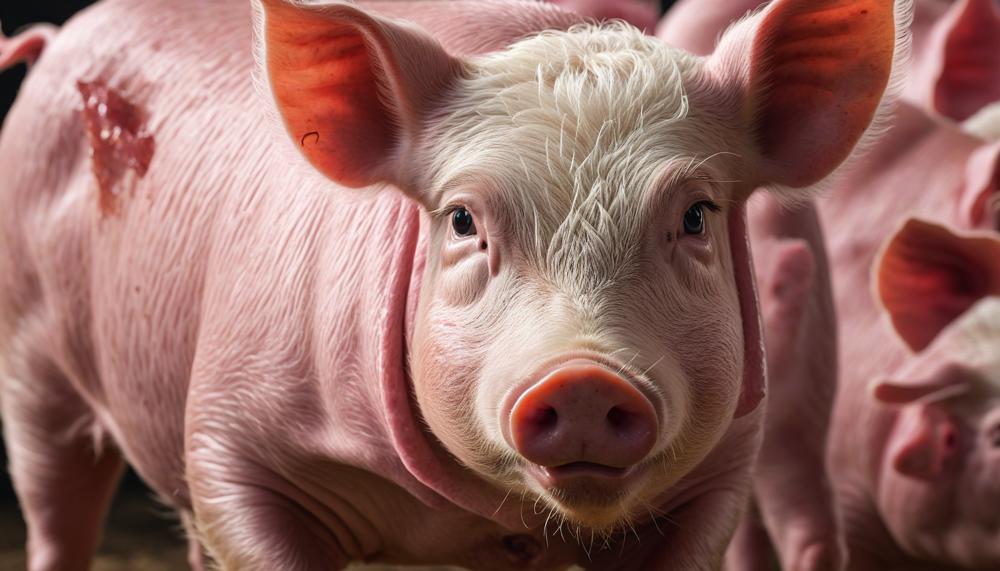No, pork should not naturally smell like sulfur. If you’ve ever encountered a strong sulfur smell when cooking pork, it’s understandable to feel concerned. However, this odor is not a typical characteristic of fresh pork and usually indicates external factors at play. Let’s break down the main reasons why your pork might be giving off that unpleasant sulfur smell:
- Feed and Diet of the Pig: Sometimes, the food that pigs eat can affect the smell of their meat. Diets high in certain compounds like sulfur can lead to noticeable odors once the meat is cooked.
- Bacterial Contamination: Meat that has been improperly stored or that has begun to spoil can develop a sulfur-like smell due to bacterial activity. This is a sign that the pork is no longer good to eat.
- Chemical Reactions During Cooking: Cooking pork at high temperatures can sometimes release odors that were not initially present, especially if the meat is beginning to turn.
- Packaging Processes: Certain packaging methods, like vacuum sealing, can cause a buildup of gases like hydrogen sulfide, which is released when the package is opened.
Understanding these factors can help ensure that the pork you prepare is fresh, healthy, and free of any unwanted smells. If your pork smells like sulfur, it’s best to assess its freshness and consider these points before proceeding with cooking.
Contents
How to Tell If Pork Is Bad
Determining if pork is bad involves using several senses to assess its quality before cooking. Here’s a detailed guide:
Observe the Colour:
Fresh pork should have a pinkish-red hue. A gray or deep brown coloration suggests that the pork may have gone bad.
Smell the Pork:
Fresh pork should have a mild, almost neutral scent. If you encounter a sour or ammonia-like smell, the pork is likely spoiled.

Feel the Texture:
The pork should feel firm to the touch. Any sliminess or sticky texture is an indicator of spoilage.
Check the Expiration Date:
Always look at the sell-by or use-by date on the packaging as a preliminary check.
Assess After Cooking:
Properly cooked pork should be tender and juicy.
If it smells off or becomes tough and chewy, it may have been spoiled prior to cooking.
What Makes Pork Go Bad?
Bacteria make pork go bad. When pork is exposed to temperatures between 4°C and 60°C (39°F and 140°F), bacteria multiply rapidly. Proper storage at cold temperatures is essential to prevent bacterial growth.
| Cause | Details | Prevention |
| Bacterial Growth | Bacteria like Salmonella and E. coli thrive in the danger zone (4°C to 60°C). They produce toxins that cause spoilage and foodborne illness. | Keep pork refrigerated below 4°C (39°F) or frozen at -18°C (0°F). Cook thoroughly to an internal temperature of at least 63°C (145°F). |
| Moisture | High moisture levels create an ideal environment for bacterial growth. | Store pork in airtight containers or vacuum-sealed bags to reduce moisture exposure. |
| Improper Storage | Leaving pork out at room temperature accelerates bacterial proliferation. | Always refrigerate or freeze pork promptly after purchase or preparation. |
How Long Before Pork Goes Bad?
Pork can go bad within 3 to 5 days if stored in the refrigerator at or below 4°C. In the freezer, properly wrapped and stored pork can last for 6 to 12 months. For cooked pork, it remains safe for consumption for 3 to 4 days when refrigerated, and can be frozen for 2 to 3 months.
Understanding Pork Spoilage: The spoilage of pork depends on several factors including storage temperature, the specific cut of meat, and how it was prepared. It’s imperative to rely on your senses to assess pork’s freshness; any off smells, a slimy texture, or discoloration are telltale signs that the pork should not be consumed. Remember, cooking cannot revert spoiled meat back to a safe state.
Here’s a handy table for reference on pork storage:
| Type of Pork | Refrigerator (at or below 4°C) | Freezer |
| Fresh Pork | 3-5 days | 6-12 months |
| Cooked Pork | 3-4 days | 2-3 months |
To maximize the shelf life of pork, ensure it is stored correctly by wrapping it tightly and keeping your refrigerator at the optimal temperature. Frequent checks for any signs of spoilage before use are recommended.
What Happens If You Cook Bad Pork?
Cooking bad pork, even at high temperatures, does not make it safe for consumption. While heat may destroy bacteria, it does not neutralize the toxins that bacteria like Staphylococcus aureus can produce. These toxins can withstand cooking and lead to food poisoning.
Symptoms of consuming spoiled pork include nausea, vomiting, diarrhea, and abdominal pain. It is crucial to recognize that no amount of cooking can reclaim pork that has spoiled; thus, it should be discarded to prevent health risks.
Below is a table that illustrates the effects of cooking on different aspects of spoiled pork:
| Aspect of Pork | Effect of Cooking | Health Implication |
| Bacteria present | Most bacteria killed | Potential remaining toxins can cause illness |
| Physical appearance | May appear normal | Does not indicate safety; toxins invisible |
| Odour and texture | Some odours and textures might seem corrected | Misleading; spoiled indicators might be masked |
For individuals passionate about grilling or cooking, it’s essential to use only fresh, well-stored pork to ensure safety and quality in your dishes. Trust your senses to detect any signs of spoilage, and when in doubt, it’s better to err on the side of caution and discard questionable meat.
What Happens If You Eat Bad Pork?
| What Happens If You Eat Bad Pork? | ||
| Consequences | Symptoms | Prevention |
| Eating bad pork can lead to severe food poisoning. | Nausea, vomiting, diarrhea, stomach cramps, fever, and dehydration are common symptoms. | Properly store and cook pork to avoid consuming spoiled meat. |
| In some cases, hospitalization may be necessary. | Severe cases can result in hospitalization and, in extreme situations, death. | Trust your senses—discard any pork that looks or smells off. |
When you consume spoiled pork, you’re risking more than just a stomach ache. Bad pork harbours dangerous bacteria like Salmonella, Listeria, and E. coli, which can wreak havoc on your health. Symptoms manifest quickly: expect nausea, vomiting, and the dreaded diarrhoea. Stomach cramps and fever may follow suit, dehydrating you faster than you can say ‘bad pork’.
Should things take a turn for the worse, hospitalisation might be your next destination, or worse yet, you could be staring down the grim reaper himself. Properly handling and cooking your pork is paramount. Store it right, cook it well—never let it linger or loiter.
The Pork Smells Bad But It’s Not Expired
The most likely culprits behind the unpleasant smell in pork that hasn’t reached its expiration date are bacterial contamination and improper storage. Even if pork is within its use-by date, it can still become unsafe to eat if bacteria have had a chance to proliferate.
These bacteria can produce gases and compounds that emit strong, off-putting odors, signaling that the meat might be spoiling despite what the date indicates. Here’s a closer look at the main factors:
Bacterial Contamination
Even under ideal circumstances, pork can be exposed to bacteria during processing or handling. If these bacteria aren’t effectively eliminated through proper cooking or if the meat is left at temperatures that encourage bacterial growth, they can multiply, affecting the pork’s smell and safety.
Improper Storage
Storing pork in conditions that are either too warm or too moist can hasten spoilage. Pork needs to be stored at temperatures below 4°C (about 39°F) and with adequate air circulation to keep it safe.
| Factor | Impact on Pork | Signs of Spoilage |
| Bacterial Contamination | Can cause odors and spoilage before the expiration date. | Bad smell, slimy texture |
| Improper Storage | Accelerates bacterial growth and spoilage. | Foul odor, color changes |
Grill enthusiasts should be particularly vigilant, as the aroma and flavor of the pork are essential for a delightful meal. It’s crucial to trust your senses; if the pork smells off, it’s better to err on the side of caution and discard it, regardless of the expiration date.
Always ensure pork is stored correctly right after purchasing and remains properly sealed in a cold environment to prevent such issues.
How to Keep Pork Fresh for Longer
Refrigeration
- Store Immediately: Place fresh pork in the refrigerator as soon as possible.
- Temperature: Keep the refrigerator at 4°C (40°F) or lower to inhibit bacterial growth.
- Packaging: Keep the pork in its original packaging if it will be used within a couple of days. For longer storage, rewrap it tightly in plastic wrap or aluminium foil.
Vacuum Sealing
- Seal Fresh Pork: Use a vacuum sealer to remove air from the packaging, significantly extending its shelf life by preventing bacterial growth and oxidation.
- Storage Time: Vacuum-sealed pork can last 1-2 weeks in the refrigerator or several months in the freezer.
Freezing
- Preparation: Wrap the pork tightly in plastic wrap, then place it in a heavy-duty freezer bag. Alternatively, use vacuum-sealed bags.
- Temperature: Ensure the freezer is set at -18°C (0°F) or lower.
- Storage Time: Pork can be frozen for 4-12 months depending on the cut. Ground pork lasts around 3-4 months, while larger cuts like roasts can last up to 12 months.
Marinating
- Use Marinades: Marinating pork can help to extend its freshness. Acids in marinades, like vinegar or lemon juice, slow down bacterial growth.
- Refrigeration: Always marinate pork in the refrigerator, not at room temperature.
Airtight Containers
- Storage: Place pork in airtight containers to prevent moisture and air from spoiling the meat.
- Material: Use glass or BPA-free plastic containers with tight-fitting lids.
Handling and Hygiene
- Clean Hands and Surfaces: Always wash hands and surfaces before and after handling raw pork to prevent contamination.
- Separation: Keep raw pork separate from other foods in the refrigerator to avoid cross-contamination.
Conclusion
Pork emitting a sulfur-like smell is a clear deviation from its natural state and signals a potential issue, not inherent to the meat itself.
The reasons for this off-putting aroma are manifold. Diets rich in sulfur compounds can impart similar scents to the meat post-cooking.
More alarmingly, the presence of such a smell often points to bacterial contamination, signaling that the meat may have been compromised due to improper storage or that it’s starting to spoil. Additionally, certain cooking methods and packaging, especially vacuum-sealed packs, can trap gases that release this distinctive odor upon opening.
To ensure you’re serving pork that is both safe and enjoyable, vigilant attention to its freshness and storage conditions is crucial. Always conduct a thorough sensory check before cooking—observe the color, feel the texture, and most importantly, trust your nose.
By understanding and mitigating these factors, you can safeguard against undesirable odors and ensure your pork dishes remain a delightful culinary experience, free from surprises.






